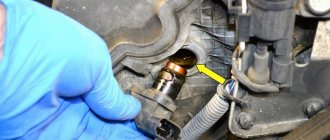A good car battery should have about 12.6 V. And when the car does not start, a low-charge or completely discharged battery is most often to blame. Most rechargeable batteries are guaranteed for 3 years. Only 30% of their number today are able to withstand this period.
Unfortunately, many car enthusiasts do not monitor the operation of the battery until it fails. To prevent this important device, experts recommend checking the battery charge with a multimeter at least twice a year. When performing testing, the user must know how many volts a charged battery should show.
It's a simple process. Before checking the battery with a multimeter, access to its terminals is released and tested in the “rest voltage” mode, that is, the device is checked when the car has been standing all night without moving.
Experts believe that this test result will be more accurate.
What is a multimeter
This is a household digital measuring device that is used to determine voltage (U), electric current (I) and battery resistance. Most often, this device determines U in a car battery. The digital meter has a high degree of accuracy, has wide functionality for measured parameters and quantities, and is also easy to maintain.
When measuring U in a car battery, it helps the user know how much capacity the battery has. Analysis of the test results obtained is very important, since it gives an idea of the performance of an important element of the vehicle's energy supply.
Purpose and differences of multimeters
A multimeter is an electrical measuring device that combines several functions. Measuring devices of both household and professional grade are available on sale. The significant difference between these classes lies in the accuracy of the results obtained, which ultimately affects the price of the devices. Household-grade devices allow you to measure various quantities over a wide range of values with low accuracy, while professional testers are more focused on a small group of measurements with a small error.
Based on their operating principle, meters are divided into two types:
- analog;
- digital.
You can measure battery parameters with any of these types of devices, but a digital multimeter is more popular among car enthusiasts. This is due to the ease of use and a more visual representation of the measurement result, compared to an analog tester.
The operating principle of an analog tester is based on the conversion of the measured signal into current, followed by its visualization in the form of a needle deflection by a certain amount. A digital device, having microcontrollers in its device, converts the received signal into voltage, and after processing it, displays it on the display in the form of numbers.
Pointer type voltammeter
The main element of this type of device is the electromechanical head. Being made in the form of a frame with an arrow and being under the influence of an alternating magnetic flux, it converts the electrical signal that comes through the measuring probes and elements of the device into a mechanical deflection of the arrow. The strength of this deflection is related to the amount of current detected by the head.
The calculation error of this type of device depends on the sensitivity of the measuring head. The probability of a measurement error with a pointer tester is indicated by a number, for example, 0.1 or 2.0, and is called the accuracy class. Thus, a device with a measurement range from zero to 25 volts and accuracy class 1 will be able to determine the voltage value on a car battery with an error of 0.25 volts. The advantage of the analog type compared to the digital one is its inertia and poor sensitivity to external interference, which allows you to check the battery with a tester with good accuracy.
Digital view meter
The operation of a digital voltage meter is based on the use of an analog-to-digital converter (ADC) in its circuitry.
This microcircuit is the core of the device, the quality of which largely determines the error of the result obtained. In addition, the accuracy class depends on the parameters of the radio components in the device, the quality of the implementation of protection from the external negative influence of electromagnetic fields. The main characteristic of this type of device is its capacity. The higher the bit class, the greater the measurement accuracy will be. We recommend: How to choose a 90 A/H battery based on price and features of modern batteries For example, if you use a multimeter to test a car battery with a discharge value of 2, the error in the result will be about 10%. The average value for household class devices when measuring constant voltage is only about 0.3 percent.
An important characteristic of a digital tester is the display capacity. This characteristic indicates how many digits the device can display on the screen. For example, when the bit depth is 3 3/4, this means that the largest value of the measurement value will be 3999. It should be noted here that the accuracy of the multimeter does not depend on the bit depth of the screen, which characterizes the quality of the screen.
Why is an external battery inspection performed?
They are usually located on the side of the engine in the engine compartment. If the battery is not visible when opening the hood, then the driver should study the instructions for the car in order to accurately determine the location of the battery and the procedure for checking it. In modern cars, the battery is equipped with a protective plastic cover, which can be hinged and come off by simply tilting and bolted, which requires their dismantling. Some designs may have a separate protective opening red cover over the positive (+) terminal.
Important! When the cover is removed from the battery, the car owner, before checking the battery charge with a multimeter, must be extremely careful to ensure that wrenches or other steel objects do not touch the connections and create a risk of short circuit.
Experts advise carrying out an external inspection of the battery as often as possible. For example, whenever the driver opens the hood of the car. During operation of the machine, dirt accumulates on the surface of the battery, washed away by moisture, and electrolyte drips that form as a result of its boiling. In addition, other signs of malfunction may be detected on its surface, which must be eliminated in a timely manner. Before testing with a multimeter, such an external check is mandatory.
"Green Window"
Some types of batteries have a built-in indicator , this invention came to us from Japan, after which most companies began installing it on maintenance-free types.
The essence is simple, on the right or left, it also happens that there is a small peephole in the middle, in which there is a slight glow - an indicator. It has three positions, very easy to check:
- Green – the battery is fully charged.
- White – low electrolyte level.
- Black – the battery is discharged and needs to be recharged.
As you can see, if you have this option, then you don’t actually need a multimeter and a load fork. We arrived at the parking lot, opened the hood, looked at the indicator, and made a decision. If there is no “green window”, recharge immediately.
However, these types are not cheap, they cost about 20 - 30% more than the average battery, many drivers save money, and therefore this test will not pass! Let's move on to the next methods.
How to find out if your car battery is bad
The most common symptoms that appear during car operation and are associated with a faulty battery are the following:
- The AK battery indicator is always on on the dashboard of the car.
- The engine does not start or cranks slowly when starting.
- The car can only be started from an external source.
- A distinct click is heard when the engine is turned on.
- Dim headlights.
- The car stopped starting.
Common causes of battery discharge
Batteries are often discharged both due to the fault of the car owner and due to third-party reasons. Of course, the most common reason for a suddenly dead car battery is driver absentmindedness, that is, electrical appliances left on - headlights, lights, radio, etc.
But a much more impressive list is being compiled due to technical problems:
- battery contamination;
- long service life (more than 4 years);
- damaged, outdated vehicle wiring;
- incorrect connection of electrical appliances;
- problems with the generator or its regulator;
- incorrectly selected battery;
- change in electrolyte level and density;
- Frequent trips over short distances at low speeds.
What could be wrong with a car battery?
Poor technical condition and a dirty battery lead to self-discharge currents. Common problems with a poor device are corrosion of terminal connections and leakage currents from the vehicle's electronics. If in this case you do not recharge the battery in time, then a deep discharge occurs on it, resulting in sulfation of the plates, which significantly reduces the life of the battery.
As a rule, electrolyte stains are removed with a soda solution prepared in the ratio: 1 teaspoon of soda per 200 ml of water. The result is a saturated alkaline solution that neutralizes the acid. Before checking the battery charge, the corrosion on the terminals is cleaned with sandpaper. At the same time, all work is carried out in compliance with safety measures: gloves and safety glasses.
Important! When checking the battery with a multimeter, the driver needs to take time to check the technical condition of the battery box. If it is loosely secured, especially in winter, the plastic case of the battery becomes very fragile and cracks may form on it.
What characteristics are measured with a multimeter?
This meter can accurately measure: voltage, capacity, battery resistance, “leakage current” and determine “dead cells”. Similarly, you can check the amps using a multimeter.
Important! Before checking the car battery charge with a multimeter, wear rubber or waterproof gloves when working with ABK, since it contains lead-acid solutions and this will help avoid chemical burns on the performer’s skin.
Before measuring the current with a multimeter, and also to obtain reliable measurements, it is recommended that the vehicle be left at rest for at least 1 hour, and experts advise that testing be carried out in the morning, after the vehicle has been idle overnight.
To accurately determine the technical condition of a battery, 3 types of measurements are performed with a multimeter:
- No. 1, when the ignition is turned off, the engine does not work, and the multimeter is set to constant electric current mode;
- No. 2 let the machine run for a minute and, with the engine running, turn on the constant network measurement mode;
- No. 3 operation of the engine at idle speed in alternating current mode.
In the process of processing the test results, it can be concluded that the battery needs to be replaced if the following conditions are met for each measurement:
- No. 1 - voltage values below 12.2 V.
- No. 2 - values above 14.7 V. In addition, provided that the voltage is below 13.7 V, this will mean that the battery is discharged or the generator is not working, which does not charge it. If U exceeds 15 V, this clearly indicates that the generator is not working.
- No. 3 - values above 200 mV.
Capacity
You can also use a multimeter to quite easily check the current capacity of the battery installed in the engine compartment of your car.
To do this you will need to perform several procedures:
- Fully charge the battery first to get accurate readings.
- Now connect the load. Maybe the same light bulb. It is important to know what current consumption the connected device has.
- Record the time during which the load will function normally.
- At the same time, connect the meter probes to the battery and switch the device to the mode for measuring constant voltage parameters. The limit will be 20 V.
- This procedure is needed to monitor changes in the potential difference, turning off the load when the indicators drop to minimum values.
- Next, you can understand how to measure the capacity of your battery using a multimeter and a load. To do this, multiply the current that the load consumes by the time during which it worked on a fully charged battery.
Compare the obtained values with the optimal characteristics written on the battery case.
How to measure voltage
The initial test with the instrument is performed in constant mode, which is indicated by a straight line above the V on the panel. Before checking the battery voltage with a multimeter, set the measurement indicator on the dial to 20 V.
The red probe touches the “+” terminal, and the black probe touches the “−” terminal. If during testing the user receives readings on the display, for example, −12.6 V, and not +12.6 V, then the probes are mixed up and are swapped.
The minimum permissible voltage when measuring the battery is above 12.6 V. At U = 12.2 V, it is charged no more than 50%, and at U = 12 V it will need to be recharged from the car charger.
Before you check the car battery for performance, you should keep in mind that almost all modern cars are subject to “parasitic losses” or “leakage current” when electrical receivers drain the battery even when the engine is not running, for example, digital watches and other devices. To establish the “leakage current” and thereby eliminate voltage losses, after charging the battery and leaving the engine overnight, check the voltage. If it falls, you need to turn off those devices that were turned on and are not required for the car to function.
Amperage
The battery can discharge on its own if there is no power, this is a natural procedure. Acid batteries incur large losses. Acceptable leakage current values are from 50 to 80 mA. So the security alarm consumes 20 mA, the radio - 3, the injection system - 5, etc. If the current is consumed normally, the battery will last for more than one year. A leak may also occur due to a malfunction if:
- there are wet areas of the electrical circuit;
- There are sections with thinned insulation.
In these situations, the battery may completely discharge and a fire may occur in areas of weak electrical wiring. When checking the battery for leakage with a multimeter in the current (ampere) mode, make sure that the indicator does not exceed 80, since the battery will quickly run out.
To prepare the car for testing, turn off: lights, all instruments, radio, etc.
Leakage current measurement
Step-by-step diagram for connecting the measuring device:
- First of all, the measuring device is set to the 10 ampere position.
- The red connector goes into the “10 ADC” socket.
- Remove the terminal from the power source and connect the red wire of the ammeter to it.
- Place the black wire of the testing device on the disconnected terminal.
After all manipulations, all indicators should be absent on the device screen. If some numbers suddenly appear, then the leakage current is significant, you need to diagnose the on-board system of the vehicle.
Attention! When checking the battery for a short circuit, also use a multimeter; if the contacts spark, you must urgently disconnect the device, as you can “burn” it.
Other
Using a universal measuring device, the voltage of mobile phone batteries is checked, for this purpose the measuring device is set to the 20 V position for direct current, the accuracy of these readings is up to 0.01 V.
How to measure battery capacity
The multimeter can be used as a tester to establish the battery capacity with a test discharge on the battery. First, fully charge the battery, check the current with the device according to the above method and specify the density of the electrolyte, according to the instructions of the battery manufacturer.
Before checking the battery amperage with a multimeter, connect a load with specified parameters to the battery, for example, a regular 24 W light bulb, and note the time it takes to connect the load. When the battery voltage drops to 50%, the light bulb is turned off.
The battery capacity is measured in A/h, the actual result is obtained by multiplying I with the light bulb connected by the number of hours of its operation. If the result corresponds to the nominal value indicated by the manufacturer in the battery passport, then it meets the operational requirements, that is, it is operational. Otherwise, it requires repair or replacement.
Battery capacity tests
The concept of battery capacity means how long it can work with optimal output of a certain amount of charge at certain U values. Capacity is measured in ampere-hours, and each battery is usually marked with its nominal capacity. The most common way to check a battery's capacity level is to place a specific load on it.
This is interesting: Solar panels for the home: important points
It would be best to use the load by temporarily unscrewing the car headlight, because the headlight has a power of 35-40 watts that is suitable in all respects. This means that the headlight, when connected to the battery, will take the required half of the current so that you can find out whether the battery capacity is normal. If the headlight goes out quickly, it means that the battery capacity, unfortunately, is not enough.
In order to determine whether the battery capacity is normal, you need to do the following:
- disconnect the battery from the car's alternator;
- connect the headlight load;
- leave the battery in this position , let it work under load for about two minutes;
- disconnect the headlight;
- set the voltage measurement mode on the multimeter ;
- take measurements of indicators.
If the battery is in good condition and has sufficient capacity, U must necessarily exceed 12.4 V. This figure should be remembered. If the voltage of the battery being tested is 12.4 V or less, this is an alarming signal that with such indicators the battery will not work for a long time and may fail at any time.
You can also check to see if the battery capacity is normal using a method called test discharge. This means that the battery needs to be charged and the load must be applied to it in such a way as to provide a current strength during discharge equal to that indicated in the technical data sheet of the battery.
To do this, we carry out the following actions:
- fully charge the battery;
- We carry out the load in accordance with the indicators indicated in its data sheet;
- connect a multimeter to the circuit - it will show the amperage level;
- monitor the multimeter reading and note the time during which the amperage decreases by 50 percent or more;
- compare the data obtained with the current data in the battery data sheet.
If the differences between these indicators are small, the battery is quite suitable for further use, the capacity is in order. If the difference is large, this is a signal that it is either time to charge the battery or replace it if necessary. You cannot directly obtain numbers indicating the battery capacity using a tester.
This is interesting: What determines the efficiency of solar panels and how to increase this indicator
How to check a battery for internal resistance
A similar method of checking the health of the battery, but with measuring internal resistance, is also carried out for batteries using a household tester.
The light bulb must have a power of 12 W, and the device measures the U of the battery, both before and after connecting the light bulb.
Before checking the battery capacity with a multimeter, connect the light bulb to the battery and measure the initial voltage. After it works for 15 seconds, then turn it off and if the difference in U is below 0.05 V, then the battery is working.
Other ways to test a battery with a multimeter
The classic way to check battery capacity is to use a test charge:
- First, fully charge the battery.
- Then the load is applied so that the discharge current is calculated according to the data from the passport.
- After this, a measuring device is connected to the circuit.
- Measure the time it takes to reduce the current to less than 50% of the desired value. This time is indicated in the battery passport.
Modern batteries in good condition lose current after approximately the specified estimated time. If this process happens faster, then the battery is losing its capacity.
How to check a car battery for the presence of “dead” cells
In practice, there are cases when the battery as a whole remains operational, but one or a couple of cells that make up the battery are faulty. This becomes noticeable when the car does not start the first time.
Batteries of the latest developments, especially those assembled in Europe, are more often classified as non-separable and maintenance-free. It is impossible to install “dead” cells in them, but some provide access to the cells. In this case, they have a common removable plastic cover.
Important! The cells are filled with a solution of water and sulfuric acid, so car enthusiasts need to work with them very carefully and take protective measures to protect themselves from acid getting on clothes and skin.
To check the cells, the user will need a battery tester and a hydrometer that measures the specific gravity of the acid solution. The level in the hydrometer determines whether the cell is “dead” by comparing the readings with the data specified by the factory of a particular battery. Afterwards, a standard test of the “resting voltage” is performed with a tester.
Advice from a professional. In modern cars, before disconnecting the battery, you need to know the security code for protecting the stereo system - otherwise, after reconnecting the battery, it will not function.











